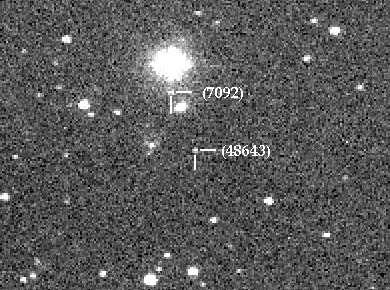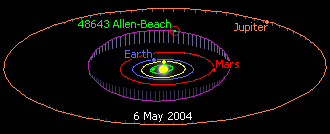
48643 Allen-Beach = 1995 UA2 = 2000 AL55 home page for48643 Allen-Beach"48643" looks like it might be a Michigan Zip code, and "Allen-Beach" sounds like it could be a nice place to hang out on a Summer's day, but "48643 Allen-Beach" is neither so close nor so warm. It orbits the Sun out past Mars in the middle of Zone I, the closest region of the asteroid Main Belt. From its brightness, this object is estimated to be roughly 2.1 km. (1.3 miles) wide*. It was discovered on 20 October 1995 by Piero Sicoli and Francesco Manca at Sormano Observatory in Italy and designated 1995 UA2. It was subsequently numbered "48643" in the 21 August 2002 numberings from the International Astronomical Union's Minor Planet Center and named "Allen-Beach" in the 6 May 2004 namings. 
EasySky screen shot Official announcement: 
Asteroid/Comet Connection publishers Bill Allen and Sally Beach (husband and wife, and longtime publishing partners) sincerely thank Piero Sicoli, Francesco Manca, and Sormano Observatory for this very special honor. Question is, does this mean we get to give our ages in "asteroid years?" With an orbital period of 1,281.38 days (3.51 Earth years), we would have had a lot fewer birthdays on "our" little planet. In fact, we're both now entering our late teens. Observing historyThe (48643) Allen-Beach pages at the Asteroids Dynamic Site (AstDyS) at the University of Pisa has orbital and other information and a link to formatted observational details. At last check there have been 344 astrometric positions reported from ten observatories during a seventeen year span, from 25 January 1993 through February 16th of this year. The most recent results, in 2009 and 2010, came from the Catalina Sky Survey telescopes on Mt. Lemmon and Mt. Bigelow in the Catalina Mountains north of Tucson, Arizona. 48643 was also reported in 2009 by La Sagra Observatory in Spain and LINEAR in New Mexico. *About sizeThe "2.1 km. (1.3 miles)" width stated above came from 2004 data. AstDys currently reports an absolute magnitude of H=15.5, which translates to roughly 2.69 km. (1.67 miles), while NASA/JPL Solar System Dynamics gives H=16.1, so on the order of 2.04 km. The SSD 48643 Allen-Beach page (with a nifty interactive orbit diagram) shows, however, that JPL's orbit solution as of 4 June 2010 hasn't been updated since observations from 26 January 2007, thus doesn't incorporate some 26% of the available data (but, not to criticize, as JPL surely has more pressing business elsewhere in the Solar System).
Page History |